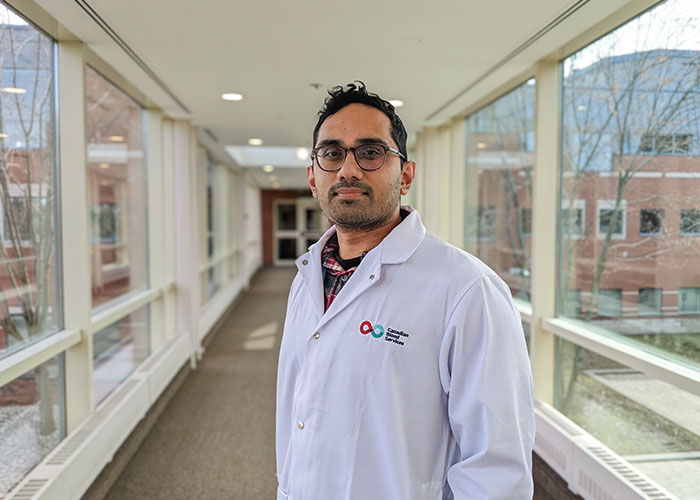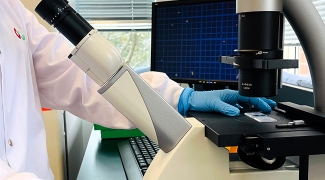Canadian Blood Services researcher studies potential treatment for sickle cell disease
Thursday, June 13, 2024 Tricia Abe
Sickle cell disease (SCD) is a debilitating genetic blood disorder that affects the production of hemoglobin, the red blood cell protein that carries oxygen from your lungs to tissues throughout your body. People with SCD may experience severe pain episodes and other serious health problems. Worldwide, SCD affects roughly 250 million people; in Canada, approximately 6,000 people are affected.
Unfortunately, treatment options for SCD are limited; regular blood transfusions may be given and medications can be used to manage pain and other symptoms or to reduce the frequency of pain crises. Until recently, the only cure for SCD was a stem cell transplant but transplants are not always effective and can have serious complications. Perhaps one of the most significant challenges for stem cell transplants is the difficulty of finding a suitable donor.
Creating healthy blood cells with gene editing
A new kind of proposed treatment—one that removes the need for a compatible donor—is being studied by Dr. Harinad Maganti, a scientist at Canadian Blood Services. His team is studying whether a one-time therapy involving gene editing of stem cells can effectively treat patients with sickle cell disease.

The proposed treatment involves extracting a patient’s stem cells, which are then grown in the lab using a patented protocol developed at Canadian Blood Services. The stem cells are gene edited to correct the single mutation responsible for causing SCD and then delivered back to the patient. Because stem cells can differentiate into many types of cells, including blood cells, the gene edited stem cells go on to develop into healthy blood cells instead of the sickled blood cells characteristic of SCD.
Although this research is still in the very early stages, Dr. Maganti stresses that it has the potential to provide a curative therapy for patients with SCD and a number of other genetic blood disorders caused by a single mutation in a gene.
“This work could mean that patients will not have to go through repeated therapies or worry about donors being available to them; they would never have to go back to the clinic again,” he says.
Testing a novel delivery system
An interesting aspect of the treatment Dr. Maganti’s team is developing is the vehicle they’re using to deliver the edited stem cells back into the patient. In other studies, viruses have been used to protect and deliver their cargo of gene-edited cells; but viral vectors have known safety risks because they can potentially cause other types of serious illnesses. To develop a non-viral delivery technology, the Maganti team is collaborating with a team at the National Research Council (Drs. Umar Iqbal and Bryan Simard) to develop and mass produce lipid nanoparticles. Unlike viral vectors, lipid nanoparticles are seen as a safer option because they disintegrate after they’ve entered the stem cells.

Already, Dr. Maganti’s team has shown that that they can gene edit stem cells outside of the body and that their lipid nanoparticles act as effective delivery vehicles in mice. Over the next few years, they’re planning more studies to better understand the effectiveness of the lipid nanoparticle therapy. This work will examine questions like: Are any off-target mutations introduced? Do different donors respond the same way to gene editing? Is it possible to deliver the gene editing machinery—the instructions needed to repair the genetic mutation—directly into patients, eliminating the need to grow and gene edit stem cells in the lab? Some of this work will be undertaken by Justine Hanotaux, a PhD candidate and recipient of a Canadian Blood Services’ Graduate Fellowship Program Award.
This research was made possible thanks to funding Dr. Maganti received this year from the The American Society of Hematology Scholar Awards Program, one of ASH’s most prestigious research award programs. He credits Drs. Jian Ping Xu, William Stanford, Caryn Ito, Freda Miller, David Kaplan and Nicolas Pineault for mentoring him during his graduate and post-doctoral training. He also credits Dr. William Sheffield, associate director of research and a senior scientist at Canadian Blood Services, for his continued mentorship. Last but not the least, Dr. Maganti is grateful to his talented, highly skilled research team and Canadian Blood Services’ blood donors, who made this research possible.
For more information about sickle cell disease and blood donation visit Sickle cell disease and blood donation | Canadian Blood Services.
Canadian Blood Services – Driving world-class innovation
Through discovery, development and applied research, Canadian Blood Services drives world-class innovation in blood transfusion, cellular therapy and transplantation—bringing clarity and insight to an increasingly complex healthcare future. Our dedicated research team and extended network of partners engage in exploratory and applied research to create new knowledge, inform and enhance best practices, contribute to the development of new services and technologies, and build capacity through training and collaboration. Find out more about our research impact.
The opinions reflected in this post are those of the author and do not necessarily reflect the opinions of Canadian Blood Services nor do they reflect the views of Health Canada or any other funding agency.
Related blog posts
Hematopoietic stem cell (HSC) transplantation therapy is used in the treatment of various blood disorders including leukemia, lymphoma, and sickle cell anemia. A recent review article published by Dr. Hari Maganti’s lab explores current advancements in pre-clinical research on the biology and mechanism of HSC homing and engraftment following transplantation.
Discover how the latest breakthroughs and promising advancements in hematopoietic stem cell (HSC) research by Canadian Blood Services scientists are enhancing HSC growth to improve transplantation and gene therapy outcomes for leukemia and blood disorders.
Since 2018, Canadian Blood Services has supported the development of evidence-based guidelines on red blood cell transfusion in patients with hemoglobinopathies through its work with the International Collaboration for Transfusion Medicine Guidelines (ICTMG). Hemoglobinopathies include sickle cell disease, thalassemia and other conditions that affect the structure, chemistry, or production of red blood cells. This blog describes recent efforts to update the ICTMG’s hemoglobinopathies guideline.


